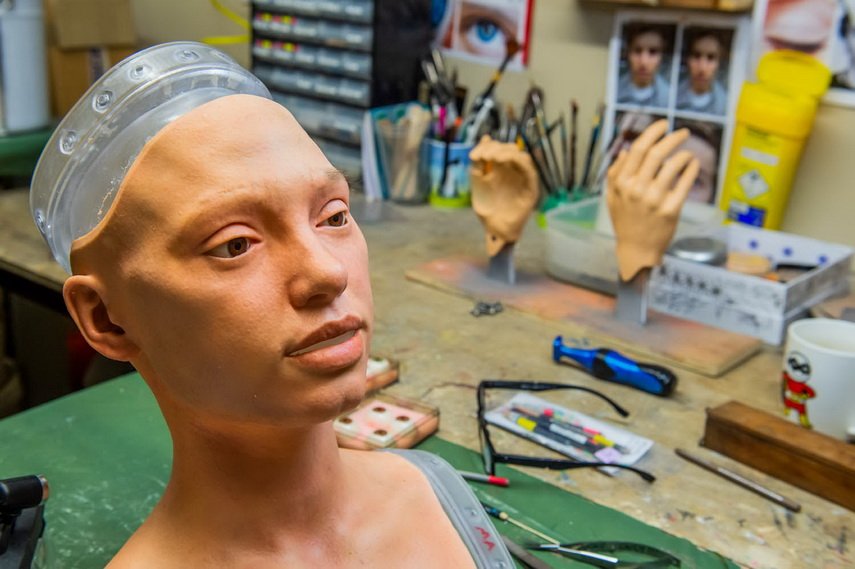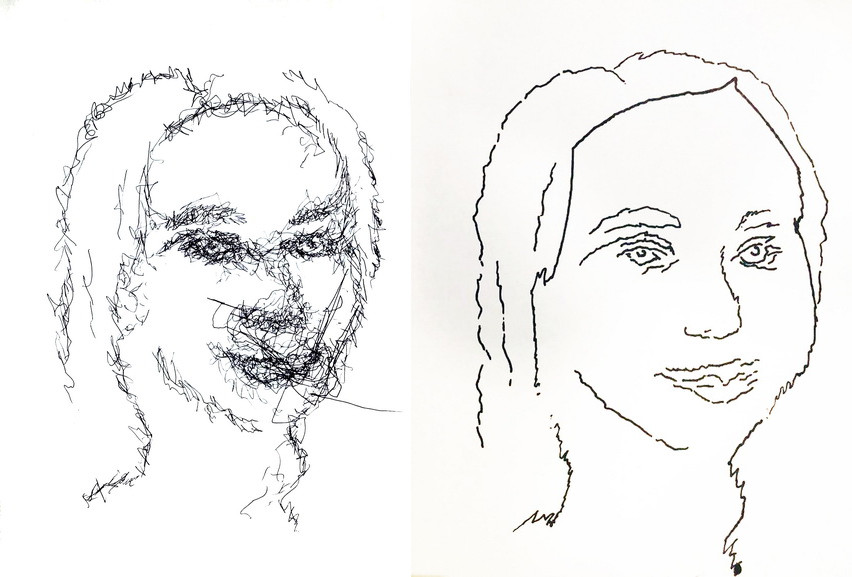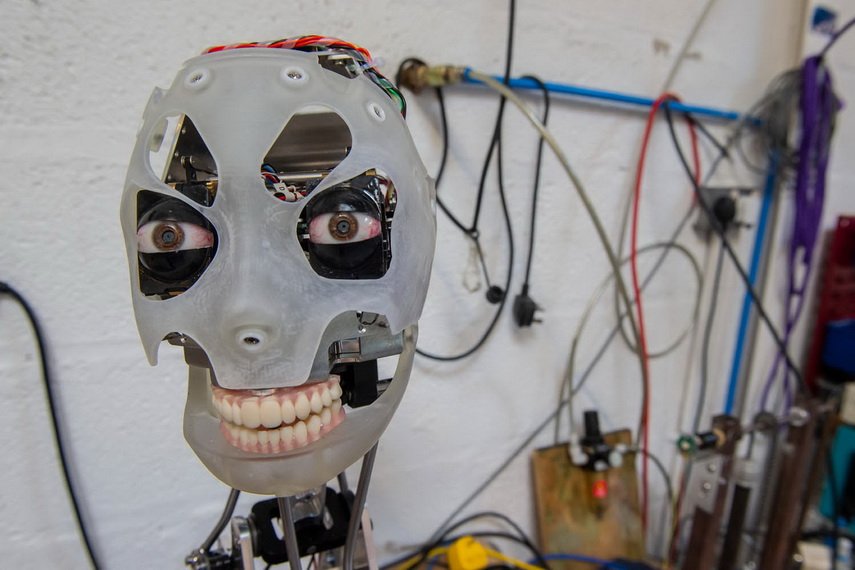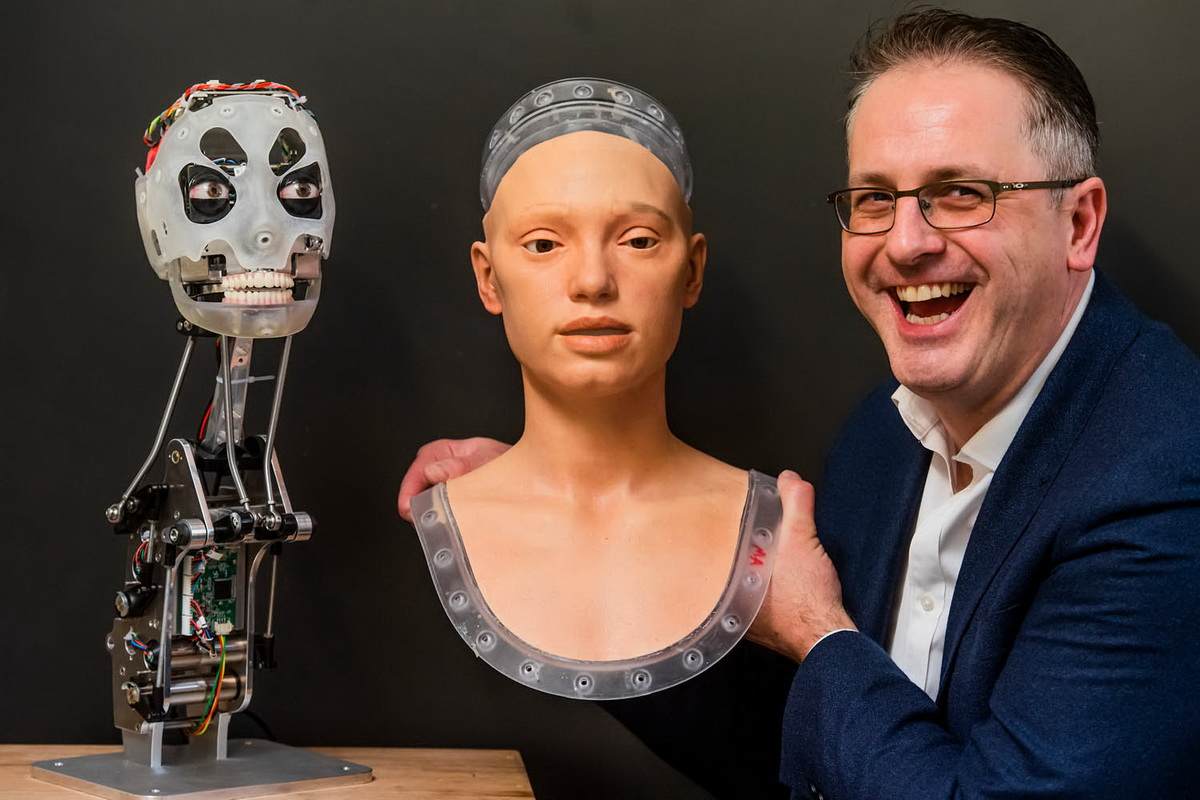[ad_1]
Every day, the global market launches the latest piece of technology constructed to enable easier, more comfortable and faster communication among humans. There is no more doubt – the future is happening now, through artificial intelligence, virtual reality, and humanoid robots such as the famous Sophia, who became a sort of celebrity.
Thanks to British art dealer Aidan Meller, in collaboration with robotics company Engineered Arts, Ai-Da came to life. Namely, this particular robot is capable of drawing almost just like humans by observing with eyes (from an inbuilt camera), and using the pencil with her hand – made possible by the use of AI-based algorithms, while facial recognition technology is used to draw human faces. Such achievement has never been seen before, which makes Ai-Da the first humanoid robot artist.
Ai-Da is currently working with pencil and pen, and she used also paint and will produce pottery pieces as well. Because of the specificity of her movements and actions, she also acts as a performance artist and engages herself in performances and videos. As a humanoid robot, she reads aloud using her own personal voice; in brief, Ai-Da is practically an art object herself, evoking current themes such as biotechnology and trans-humanism.
Between 12th June and July 6th, 2019 at Oxford University, Ai-Da will present herself for the first time physically and with her artworks spanning from drawings to videos within a solo exhibition titled Unsecured Futures. The whole installment will reflect often posed questions about the very nature of the relationship between technology and the natural world, and the role AI can or cannot have for the betterment of our societies.
In order to bring you closer to this project, we spoke with Ai-Da’s creator Aidan Meller, who was kind to share his personal reasons for launching this fascinating piece of technology.

From Art Dealing To Robotics
Widewalls: Could you tell us more about your decision to move from the general currents of the art market and focus on this pioneering project?
Aidan Meller: I’ve always wanted an interesting career, and so I like to keep innovating. Contemporary art is exciting because it’s so creative, and it’s been an aim to have a contemporary art project for a long time. Part of the process is waiting until all the ideas come together, and now it’s great to see the project unfold.
Widewalls: It is interesting that you decided that Ai-Da should engage herself in producing artworks in all sorts of media. Why do you find this important? Is this versatility important for her own future development as an artist?
AM: Many artists find experimenting in different media a stimulating and enriching process, bringing new aesthetic and practical challenges to their work.
As a robot artist, widening Ai-Da’s media choices and practices brings in fresh ideas and challenges, that result in thought-provoking artworks, often with a good measure of the unexpected! It is important that her work keeps progressing and developing, and that audiences keep responding and engaging, as this dynamic process is a very interesting aspect of the project.
Widewalls: I am especially intrigued by the Yoko Ono reference – could you emphasize a bit on that?
AM: Yoko Ono is the most remarkable artist, with a number of seminal artworks to her name. Cut Piece, 1964, re-shaped the relationship between audience and artist, as well as referencing a number of current issues around society and feminism at that time. Ai-Da similarly questions what art and an artist is, and how we relate to that, and encourages us to re-think the issue of The Other and the use and abuse of new technologies.
In one of our artworks, Ai-Da is the performance artist in an homage to Yoko Ono’s work, in which audience members are invited to ‘clothe’ her, by coming up and adding a piece of recycled fabric to Ai-Da’s robotic body.
Our use of new technologies is rapidly changing our world. The work raises issues of concealment under layers that we cannot easily decode, and unforeseen outcomes that we can’t predict. The fabric comes from second-hand shops across the country, bringing in the unknown stories and scenarios of the previous owners, and the people how originally made the clothes and the raw materials. We all impact each other, and giving too much power to technologies we still don’t fully understand needs caution and consideration, but this re-thinking is not easy to achieve in a world that seems to be rushing ahead at a breakneck pace.
Art gives us a moment to reflect, which is the aim of this homage to Yoko Ono, who knew this all too well in the 1960’s.
Ai-Da, AI Robot Artist
The Making Of Ai-Da
Widewalls: How did your own experience as a gallery owner impact Ai-Da’s existence?
AM: As a gallery owner, I am aware of the ups and downs of working in the art world, and that sometimes there are periods where things come together well, and other times when you are simply not sure which way you should go in order take the gallery forward. I’ve had to use skills like these extensively while working with Ai-Da: finding creative solutions when things take an unexpected turn, and enjoying the process as it unravels, while always keeping the big picture in sight.
Widewalls: What was the process of creating Ai-Da like at Oxford University?
AM: To do a project like this has meant we’ve had to bring in a large body of expertise and skills in a quite a diverse and disparate way, which has been very creative and enormous fun. Cross-disciplinary discussions, involving artists, biologists, programmers, mathematicians, technicians and so on, has been extremely fruitful.
Working with students and faculty members at the University of Oxford has been a real privilege, and the knowledge and dedication they’ve brought to the table has been fantastic, and we are looking forward to continued collaborations. Working with lots of people means Ai-Da and the artwork take their own organic process with various twists and turns, and the end result incorporates the element of the unpredictable, which is what we want.

The (Robotic) Artist of Tomorrow
Widewalls: Should Ai-Da be a socially or politically engaged humanoid AI robot artist? The impression is that Ai-Da is attempting to achieve self-reflection by dealing with the notion of The Other.
AM: In line with what we understand contemporary art to be, Ai-Da facilitates and reflects issues of the period (past, present and future), and this process encourages discussion and contemplation in her audiences. As a humanoid robot, she is particularly adept at stimulating engagement with ‘The Other’, and helping us reconsider this notion, not only in terms of technology, but also how we view The Other as seen in animals, the environment, the social world around us. Ai-Da herself cannot achieve self-reflection in this area, but she can help provoke it in us, her audiences.
It’s impossible to deny that we need to re-imagine our relationship to the natural world, and consider how we might repair some of the damage. Reflectively re-thinking, both personally and collectively, is a necessary first step.
Widewalls: How will this invention reflect on the further development of art in general, in your opinion?
AM: Contemporary art relies on being relevant and engaging to its audiences, whoever they may be. We are thrilled that Ai-Da is bringing in diverse audiences, from across the globe and of all ages. With such a wide-ranging impact, she will certainly be inspiring other artists, and many young people too. We will look forward to watching how they respond. We want Ai-Da to get people thinking and talking, and feeling more empowered to be creative in their lives as a whole, not just restricted to the art world.
There is no shortage of challenges ahead, and we need to be thinking about them. It’s not just the new technology and media that we are excited about with Ai-Da, it’s the engagement and discussion – if Ai-Da means the development of art can include increasingly thoughtful interaction and enthusiasm in audiences, then we’ll be thrilled.
Widewalls: What are Ai-Da’s future plans?
AM: Ai-Da plans to keep on engaging and creating! Artistic practices take time to develop, and ideas can get worked through and deepened over a number of years. Ai-Da’s artistic trajectory will be full of the unknown, which is the joy of a creative journey, and we will look forward to her audiences coming along on that journey with us.

Featured images: Ai-Da with her maker Aidan Meller; Ai-Da making of. All images courtesy of Aidan Meller. Photo credit: Guy Bell.
[ad_2]
Source link

